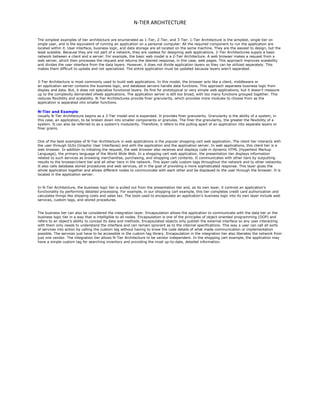
N tier architecture
- 1. N-TIER ARCHITECTURE The simplest examples of tier architecture are enumerated as 1-Tier, 2-Tier, and 3-Tier. 1-Tier Architecture is the simplest, single tier on single user, and is the equivalent of running an application on a personal computer. All the required component to run the application are located within it. User interface, business logic, and data storage are all located on the same machine. They are the easiest to design, but the least scalable. Because they are not part of a network, they are useless for designing web applications. 2-Tier Architectures supply a basic network between a client and a server. For example, the basic web model is a 2-Tier Architecture. A web browser makes a request from a web server, which then processes the request and returns the desired response, in this case, web pages. This approach improves scalability and divides the user interface from the data layers. However, it does not divide application layers so they can be utilized separately. This makes them difficult to update and not specialized. The entire application must be updated because layers aren’t separated. 3-Tier Architecture is most commonly used to build web applications. In this model, the browser acts like a client, middleware or an application server contains the business logic, and database servers handle data functions. This approach separates business logic from display and data. But, it does not specialize functional layers. Its fine for prototypical or very simple web applications, but it doesn’t measure up to the complexity demanded ofweb applications. The application server is still too broad, with too many functions grouped together. This reduces flexibility and scalability. N-Tier Architectures provide finer granularity, which provides more modules to choose from as the application is separated into smaller functions. N-Tier and Example Usually N-Tier Architecture begins as a 3-Tier model and is expanded. It provides finer granularity. Granularity is the ability of a system, in this case, an application, to be broken down into smaller components or granules. The finer the granularity, the greater the flexibility of a system. It can also be referred to as a system’s modularity. Therefore, it refers to the pulling apart of an application into separate layers or finer grains. One of the best examples of N-Tier Architecture in web applications is the popular shopping-cart web application. The client tier interacts with the user through GUIs (Graphic User Interfaces) and with the application and the application server. In web applications, this client tier is a web browser. In addition to initiating the request, the web browser also receives and displays code in dynamic HTML (Hypertext Markup Language), the primary language of the World Wide Web. In a shopping cart web application, the presentation tier displays information related to such services as browsing merchandise, purchasing, and shopping cart contents. It communicates with other tiers by outputting results to the browser/client tier and all other tiers in the network. This layer calls custom tags throughout the network and to other networks. It also calls database stored procedures and web services, all in the goal of providing a more sophisticated response. This layer glues the whole application together and allows different nodes to communicate with each other and be displayed to the user through the browser. It is located in the application server. In N-Tier Architecture, the business logic tier is pulled out from the presentation tier and, as its own layer, it controls an application’s functionality by performing detailed processing. For example, in our shopping cart example, this tier completes credit card authorization and calculates things like shipping costs and sales tax. The tools used to encapsulate an application’s business logic into its own layer include web services, custom tags, and stored procedures. The business tier can also be considered the integration layer. Encapsulation allows the application to communicate with the data tier or the business logic tier in a way that is intelligible to all nodes. Encapsulation is one of the principles of object-oriented programming (OOP) and refers to an object’s ability to conceal its data and methods. Encapsulated objects only publish the external interface so any user interacting with them only needs to understand the interface and can remain ignorant as to the internal specifications. This way a user can call all sorts of services into action by calling the custom tag without having to know the code details of what made communication or implementation possible. The services just have to be accessible in the custom tag library. Encapsulation in the integration tier also liberates the network from just one vendor. The integration tier allows N-Tier Architecture to be vendor independent. In the shopping cart example, the application may have a simple custom tag for searching inventory and providing the most up-to-date, detailed information.